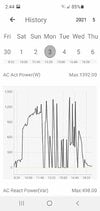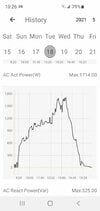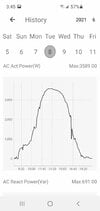@dareed1 and
@nwdiver
Here is my attempt to get yesterday’s (6/15) history of volt/amp graphs out of my delta M10-TL-US with one of versions of delta's mobile app (Mtool itself on the apple store or android was hardly helpful, i was able to find via a archive site mtool prof (M professional). and how to activate it (act code dareed gave actually). Firmware version seems to be 2.2.13.
The set of graphs are: volts/amps for one 24 hr window (06/15) PV1, PV2, (and PV3 :?)
PV1 (volt, amp, 24 hour window, dies off when the left 12 panels get shaded, so probaly tied to those)
View attachment 674265View attachment 674264
PV2 (maybe the MPPT with 2 strings tied to it? amperages are near double PV1, and its output drops at the time the right 24 panels in upper pisture start seeing shade. )
View attachment 674266View attachment 674267
PV3 ??? RE PV3: maybe just the firmware or software has the variables in it but no terminals to it. The app thinks there are 3x PV, or at least some layers of the software/firmware do. My "checkup" installer was pretty sure there was nothing in there to hook a third input up to, and it looked that way to me when we were poking around in there together ( i was an electronics tech for a number of years an age ago, so i am not totally new to this stuff, just new to solar.)
View attachment 674268View attachment 674269
NOTE the error log top page, I am not familiar with what "arc faults" mean in solar-speak, but sounds suspiciously like some wire, connector, or panel is loose and voltage is arcing across a gap. Please correct me if that is not the right idea. Looseness could be INSIDE the inverter too I guess, even bad solder joint, faulty circuitry. How would the firmware be trying to detect that? Maybe voltage drops faster than a threshold? Or maybe its just crappy firmware?
View attachment 674270
IN NEXT POST: AC active power, reactive pwr, current, freq, volts; plus the tesla apps Solar CT leg info for the same time window.





